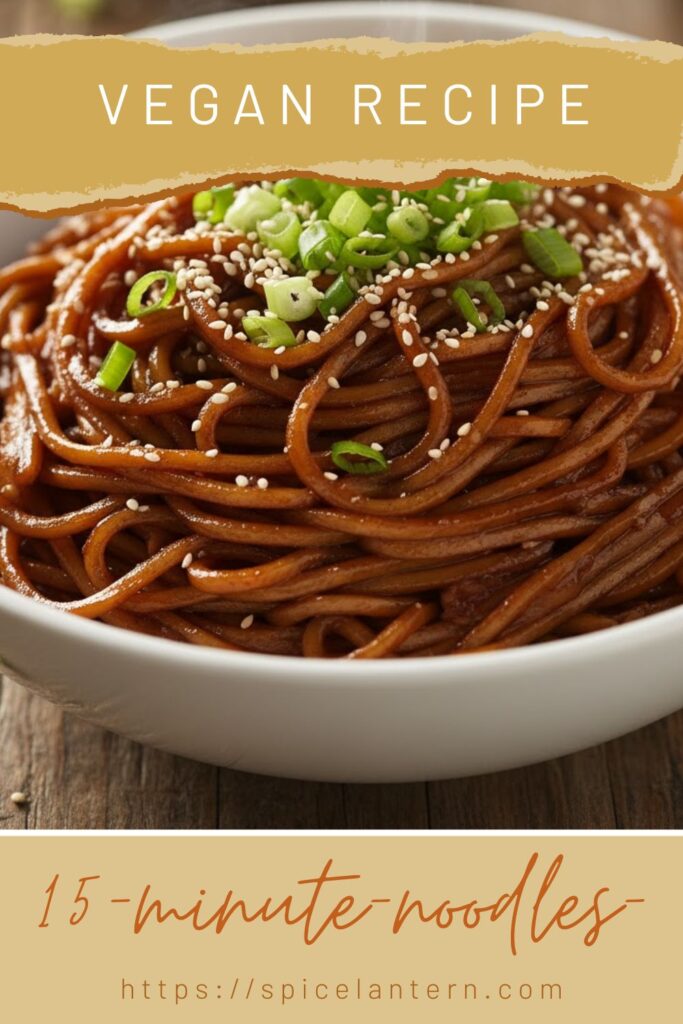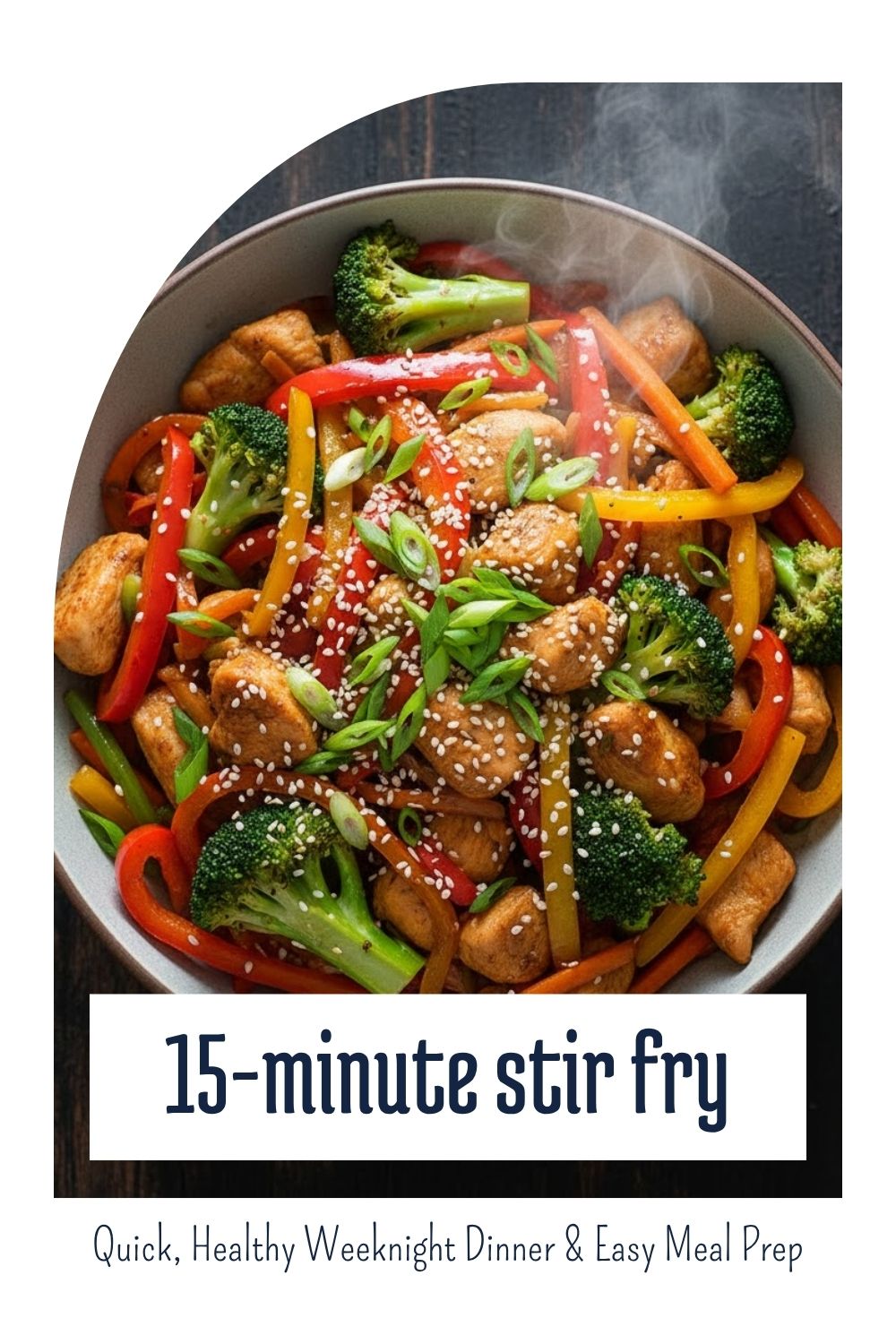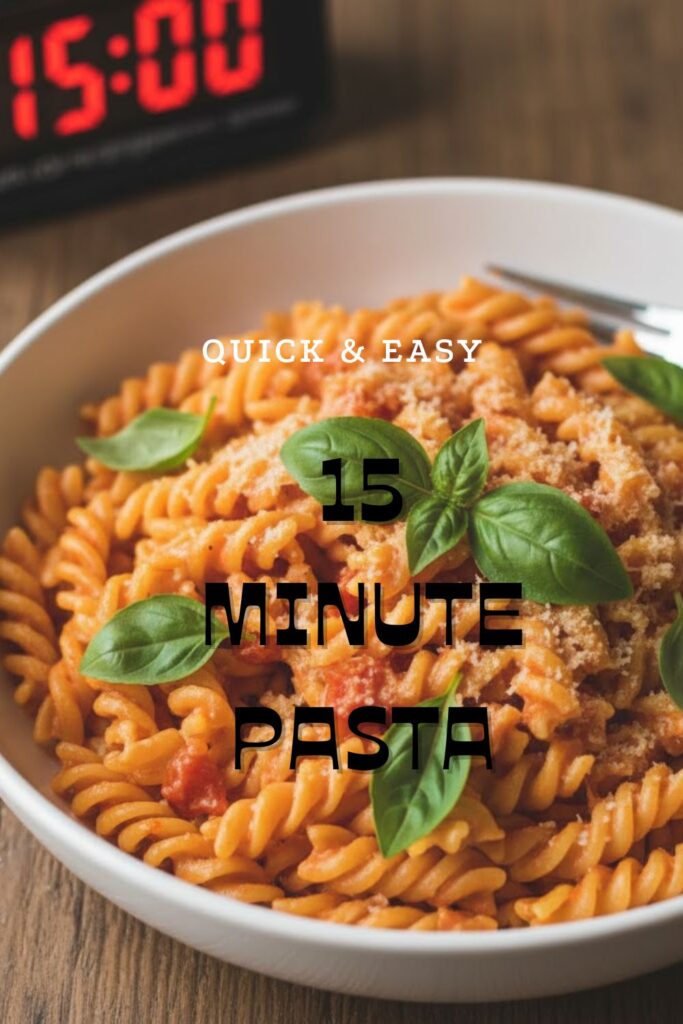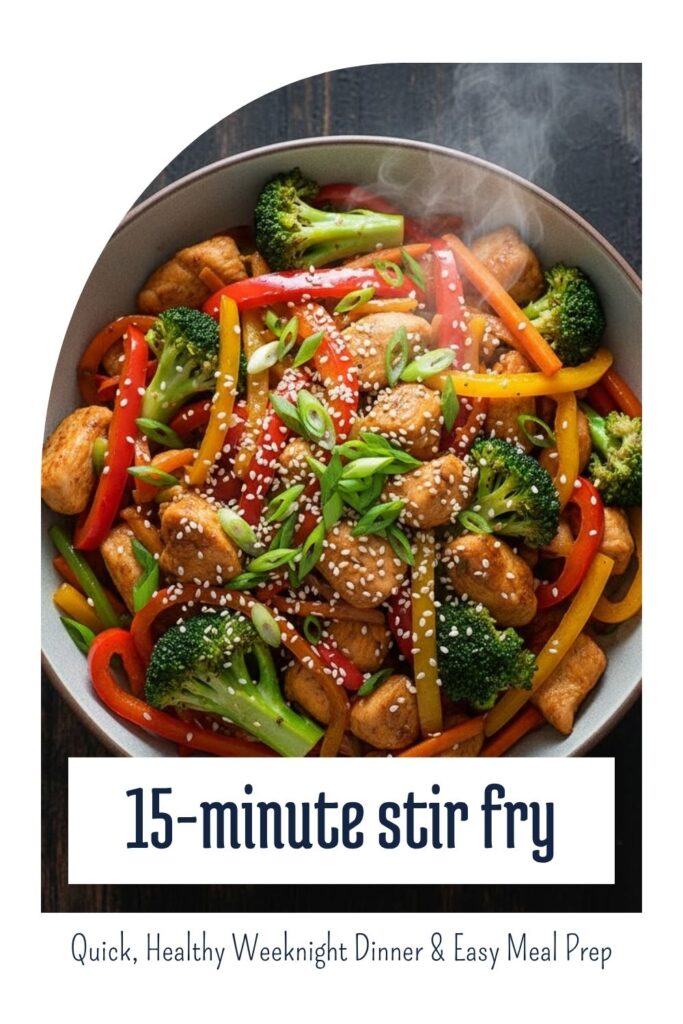🍜 Skip the Takeout: Your Guide to the Legendary 15-Minute Noodles
Let’s be brutally honest: that moment when you realize you have zero energy, zero prepped food, and a sudden, primal craving for savory, slurpable carbs? That’s peak weeknight stress. Usually, this is when the takeout apps win, and you spend $30 on something that shows up lukewarm and slightly sad. Not anymore, friend! I present to you the 15-Minute Noodles—a recipe so fast and so full of flavor, it feels like cheating. It’s better than store-bought instant ramen, and frankly, it’s faster than arguing about what to order. Get ready to cook dinner in the time it takes to watch a trailer and a half.
Why This Recipe Is Awesome (And Why You’ll Feel Like a Culinary Genius)
Why is this your new go-to? Because it achieves gourmet flavor with zero fuss.
- Actual 15-Minute Total Time: We use quick-cooking noodles and a high-heat pan to ensure you go from zero to noodle hero in a quarter hour. Prep time is minimal, cook time is 5 minutes.
- The Flavor Bomb Sauce: This isn’t just salty soy sauce; we build a complex, umami-rich, slightly spicy, and garlicky sauce that perfectly coats every single strand. You’ll never go back to those sad little seasoning packets.
- Easy Customization: This is a framework, not a prison. You can sub in whatever lonely veggies you find lurking in your crisper drawer. This dish is forgiving, which is exactly what we need on a Tuesday night.
Ingredients: The Core and the Flavor Army
Keep your pantry stocked with these essentials, and you are never more than 15 minutes away from a great meal.
- Noodles (2 servings): Quick-cooking ramen, egg noodles, or udon are ideal. Look for packages with a 3-5 minute cook time. Rice vermicelli also works!
- Oil (2 Tablespoons): Neutral oil like canola, peanut, or avocado for high-heat stir-frying.
- Aromatics: 2 cloves Garlic (minced) and 1 teaspoon Fresh Ginger (minced or grated). These are non-negotiable for flavor.
- The Sauce MVPs:
- 2 Tablespoons Soy Sauce (or Tamari): The salty, savory base.
- 1 Tablespoon Dark Soy Sauce (or more regular soy sauce): Adds a beautiful, rich color and subtle depth.
- 1 Tablespoon Rice Vinegar: Essential for a touch of tang to balance the savory notes.
- 1 teaspoon Sesame Oil (Toasted): The fragrant finish! Add this after cooking.
- 1 teaspoon Sugar (or Honey/Maple Syrup): Balances the salt and vinegar.
- ½ teaspoon Sriracha or Chili Garlic Sauce: Optional, but why wouldn’t you?
- Veggies (1 Cup Total): Quick-cooking, pre-chopped stuff! Sliced scallions, spinach, shredded carrots, or thinly sliced mushrooms.
Key Substitutions:
- Protein Power: Add in a pre-cooked, sliced chicken breast, leftover ground meat, or cubed firm tofu for a protein boost. Add it right before the sauce!
- Gluten-Free: Use Tamari instead of soy sauce and ensure you choose rice noodles or certified gluten-free ramen.
- Sugar: Use Agave or Honey if you prefer, but granulated sugar dissolves fastest.
Tools & Kitchen Gadgets Used: Speed Over Sophistication
You don’t need a fancy wok (though it helps!). You need speed.
- Small Saucepan or Kettle: For boiling the water quickly.
- Large Pot: For cooking the noodles (or soaking them, depending on the type).
- Wok or Large Skillet (Cast iron or non-stick): Ideal for high-heat cooking. A large skillet works just fine, too.
- Small Bowl: For mixing the sauce. Do this first!
- Colander or Strainer: For draining the noodles (unless you’re feeling extremely reckless).
- Sharp Knife and Cutting Board: For rapid chopping of aromatics and veggies.
- Tongs or Wooden Spatula: For quick stirring and tossing.
Step-by-Step Instructions: The Stir-Fry Sprint
Time yourself! Can you beat the clock?
Step 1: Prep and Boil (5 Minutes)
- Boil water: Get your water heating immediately.
- Mix the sauce: In your small bowl, whisk together the soy sauce, dark soy sauce, rice vinegar, sugar, and chili sauce. Set it right next to the stove. This is your life support.
- Mince your aromatics: Chop the garlic and ginger. Slice your veggies. Place them all on the cutting board near the pan.
Step 2: Cook the Noodles (4 Minutes)
- Once the water is boiling (that was fast, right?), add your noodles and cook them according to package directions, minus 1 minute. We want them slightly underdone (al dente). They finish cooking in the wok.
- Drain the noodles and give them a quick rinse with cold water to stop the cooking. A quick rinse prevents sticking! Set them aside.
Step 3: Sear the Aromatics (2 Minutes)
- Heat the oil in your wok or skillet over medium-high to high heat. You want it hot!
- Add the garlic and ginger and stir-fry for about 30 seconds. DO NOT BURN THE GARLIC! Burnt garlic is a crime.
- Toss in your veggies (carrots, mushrooms, etc.) and stir-fry for about 1 minute until they soften slightly but still have a good crunch. If you’re using pre-cooked protein, toss it in now to heat through.
Step 4: The Flavor Fusion (2 Minutes)
- Add the drained noodles to the pan.
- Pour the entire sauce mixture over the noodles and toss vigorously using tongs. Make sure every strand is coated in that glossy, dark, amazing sauce.
- Stir-fry for 1 minute to finish cooking the noodles and let the sauce reduce into a nice glaze.
Step 5: The Grand Finish (1 Minute)
- Remove the pan from the heat.
- Drizzle the toasted sesame oil over the noodles and toss one final time.
- Transfer immediately to a bowl. Garnish with those fresh scallions and maybe a sprinkle of sesame seeds. Success!
Calories & Nutritional Info: The Delicious Details (Estimated)
These are estimates for one generous serving, without extra protein like meat or eggs.
- Calories per serving (1 serving without added meat/tofu): ~380-450 calories
- Carbohydrates: ~60-75g
- Protein: ~8-12g
- Fat: ~10-15g
- Fiber: ~3-5g
Nutritional Notes:
- This recipe offers a good blend of complex carbohydrates for energy and healthy fats from the sesame oil.
- Boost the nutrients: Add quick-cooking, dark leafy greens like spinach or shredded kale right before the sauce for an extra hit of vitamins and fiber.
Common Mistakes to Avoid: From Noodle Nightmare to Noodle Nirvana
Don’t let these simple errors turn your 15-minute meal into a 30-minute stress fest.
- Not Pre-Mixing the Sauce: The sauce process is a split second. If you measure ingredients directly into the wok, you lose heat, and your aromatics burn. Pre-mix the sauce! It’s non-negotiable.
- Burning the Garlic/Ginger: High heat is great, but garlic and ginger burn fast (30-60 seconds max). Burnt aromatics taste acrid and ruin the whole dish. Watch the heat!
- Overcrowding the Pan: If you try to double the recipe in one go, the temperature of your pan drops instantly, and you end up steaming the food instead of stir-frying. Steam = soggy noodles. Cook in batches if necessary.
- Overcooked Noodles: Cooking the noodles fully in the water leads to mushy, broken noodles after the stir-fry. Always pull them out slightly early (al dente) so they can finish softening in the sauce.
- Adding Sesame Oil Too Soon: Toasted sesame oil is a finishing oil; it has a low smoke point and a delicate flavor. Adding it during high-heat cooking makes it taste bitter. Add it after you remove the pan from the heat.
Variations & Customizations: Your Noodle Playground
Ready to remix your bowl? Try these killer combinations.
- Peanut Butter Power: Add 1 tablespoon of creamy peanut butter and a splash of water (or coconut milk) to the sauce mixture. This creates a rich, satay-style noodle that is outrageously good.
- Lemony Herb Garden: Swap the dark soy sauce for fresh lemon or lime juice (2 tablespoons) and add freshly chopped cilantro/coriander and mint at the end. Perfect for a refreshing, non-traditional take.
- Miso Glazed Tofu: Instead of pre-cooked meat, pan-fry cubed firm tofu separately until crispy. Add a teaspoon of white miso paste to the sauce mixture for a depth of savory, fermented flavor.
FAQ Section: All Your Slurpy Questions Answered
You’re a noodle novice no more! Here are the burning questions everyone asks.
Q1: What is the best type of noodle for a 15-minute meal?
A: Thin egg noodles, fresh refrigerated ramen, or rice vermicelli/noodles. These typically have the shortest cook/soak times (3-5 minutes), making the 15-minute goal truly achievable.
Q2: What is the difference between light and dark soy sauce?
A: Light soy sauce (or regular) is the main seasoning, providing salinity and umami. Dark soy sauce is thicker, darker, slightly sweeter, and primarily used for adding a beautiful, rich mahogany color to the dish.
Q3: Can I add raw chicken or beef to this recipe?
A: No! Raw meat takes too long to cook, and you will steam the noodles before the protein is safe to eat. Use pre-cooked, thinly sliced, or ground meat that cooks in 2-3 minutes max.
Q4: Why are my noodles clumping together after draining?
A: You need to rinse them quickly with cold water immediately after draining. This removes excess starch, which is the main culprit for sticking. A tiny drizzle of oil and a toss also helps!
Q5: Can I make this dish ahead of time for meal prep?
A: You can, but it’s best eaten fresh. Meal prep tip: Mix the sauce and chop the veggies ahead of time (Step 1). Cook the noodles and stir-fry the dish just before serving. Leftovers can be stored in the fridge for up to 2 days.
Q6: Do I need a wok for this recipe?
A: A wok is ideal because its shape allows for maximum heat distribution and easy tossing, but a large, wide non-stick skillet works perfectly well. Just make sure the heat is high and don’t overcrowd the pan!
Q7: Should I save the noodle water?
A: In this recipe, no. However, if you are making a more complex sauce or one that needs thickening, a tablespoon of the starchy noodle cooking water can help emulsify the sauce.
Final Thoughts: Dinner is Served (Seriously)
You officially beat the clock. You have a huge, steaming bowl of savory, saucy 15-Minute Noodles that required minimal effort and tasted like maximum success. Go ahead, bask in your domestic glory. You’ll never waste money on sad takeout noodles again. You’re too good for that now.







